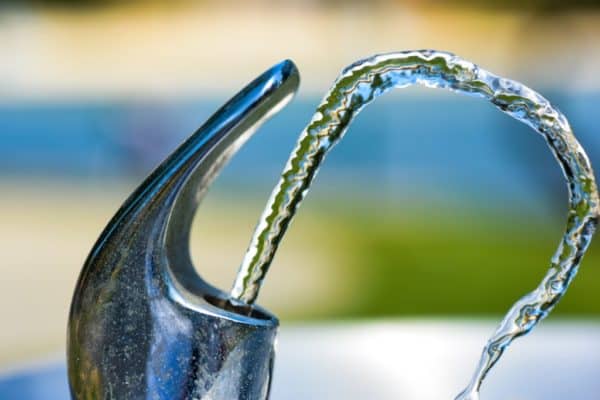Have you ever wondered why a water fountain has that odd curved thing where the spigot is? Why does it look like an ice cream scoop? What purpose does it serve?
A splash guard is a preventative measure installed into public drinking fountains for the sole purpose of preventing contact between an individual’s mouth and the water spigot. The guard is designed in such a way as to combat the spread of germs and disease.
Splash guards are typically made out of a firm plastic, wood, metal, or ceramic substance but why stop at inanimate objects? Why do water fountains have splash guards? Why doesn’t society have Splash Guards?
Fathom The Need
Lifeguards are an emblem of safety in our modern society. So how is it that we, as a people, have acknowledged the necessity and even the profession of a swimming pool lifeguard, and yet have not addressed the desperate need we have for real, highly trained operatives groomed for the express purpose of protecting our mouths from the unwanted saliva of others? Is not our oral hygiene just as, if not more important than our capacity to breathe?
After all, we use our mouths to communicate, to eat, to breathe, to protect ourselves, the list goes on and on! Imagine the depth of wide-spread contamination every human mouth is in risk of, the moment a single person decides to place the entirety of their lips around the spigot of a water fountain. Where is the protection? Where is the justice?
If this abomination is permitted to continue on, would kissing cease to exist? Think of the immense cost of neglecting to protect the most essential part of our human anatomy. A world without a human Splash Guard is a world without a future.
Unlimited Diseases
No one likes to really think about the billions of tiny germs strolling around on our hands, hiding underneath the crevices of our tongues, or even parading around the surfaces of other people. Horrifying, I know. There are around 1,500 varying kinds of germs on each square centimeter of our hands at any given time. Make you think twice before you lick your fingers after stuffing your cheeks full of hot Cheetos.
Water fountains are public domain, therefor anyone and everyone’s germs can be on a water fountain, having traveled hundreds of miles to get there. They’ve waited so long just for your specific hands. Just think, there are over 2.7 million bacteria colonies on a water fountain, which is just shy of how many bacterial colonies are on a cafeteria tray, believe it or not.
The potential these bacteria have to make a comfy home on your body is limitless, unfortunately. So, children, remember to wash your hands liberally every chance you get.
What’s the Reason for the Mouth Guard
Plenty of people, especially children, don’t know better than to not put their mouths directly on the spigot. Thus, the birth of a mouth guard. There’s not much known about the history of the mouth guard, but more than likely it was placed in order to prevent the spread of germs. As stated earlier, millions of germs thrive on the surfaces of water fountains.
The mouth guard most likely has a curved shape so that it is more difficult to place the mouth directly on the spout. Germs are contagious if ingested instead of just lingering on surfaces.
Children are most likely the culprits for putting their mouths right where the water is, but they don’t know any better. So the next time you think about drinking from a water fountain, maybe think twice about where you are, and who may have touched and contaminated it.
The Glorious History, of Yee Old Water Fountain
First, let us dive deeply into the history of the water fountain, and the dire need for a splash guard to be invented. In Nepal, the first ever public drinking fountains were found around 550 A.D. They were intricately created water spigots, made out of stonework and carved, where water flowed up freely through natural water springs under the ground.
They didn’t necessarily have great pressure, but were a source of fresh water rather than some dirty rain water. They are actually still used today, and are a source of water for many people.
Then, in the middle of the 1800’s, the United Kingdom’s private water companies were required to provide proper water filtration and create better sewage outlets for the rapidly growing population. If we all remember correctly, these same people before this time used to throw their waste right into the streets, so this was an essential step to providing their cities with better and cleaner water.
Shortly after this the first water fountain was placed on the side of the St Sepulchre-without-Newgate church, which was instantly popular. Because the fountain attached to this church gained much needed attraction, many other churches followed because they wanted their popularity to increase.
In their eyes, water fountains brought new members to the church; water fountains appeared to bring forth the prospects of the heavens.
America, the beautiful, and also the slightly intoxicated. In the United States, most decided to drink alcohol rather than water because the cleanliness of the water was unlikely. Fortunately, after the Civil War, public drinking fountains were created in the hopes that the water would be regulated more closely.
The first “Bubbler” shot water one inch straight into the air. This didn’t prove to be as sanitary, so a year later water fountains were created to have a more arched projection.
As of today, as far as the legends go, water fountains still roam freely across the land, providing fresh water to the eager mouths of millions. There’s even places to fill up your water bottles that track how many plastic bottles that could have been filled and wasted. They aren’t made of stone, but of a plastic type today, protruding around corners, awaiting the arrival of eager mouths, seeking refreshment.
